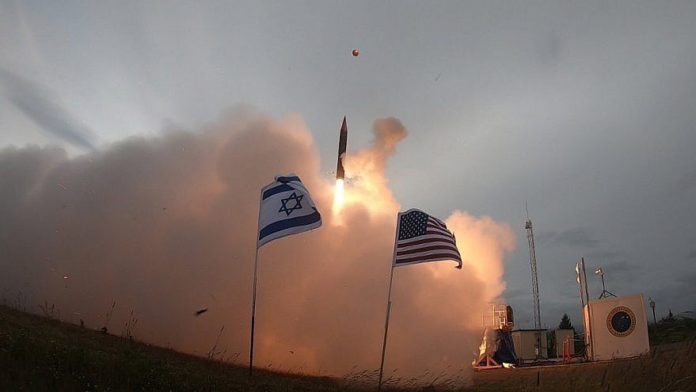
JERUSALEM (JNS) — The Sept. 14 combined cruise missile and drone attack on the Abqaiq Saudi oil facility, which caused extensive damage and has been attributed to Iran, is a “global wake-up call for understanding that the threat is here and now,” a senior former Israeli air-defense source told JNS on Thursday.
Join our WhatsApp groupSubscribe to our Daily Roundup Email
The Saudis did not have any prior intelligence warning, and their advanced air-defense systems—one of the largest in the region—failed to stop the attack, noted the source.
“We know from our own microcosm that the Iron Dome batteries must be ready at all times because threats can pop up without warning. Now, we can all see the importance in the presence of effective air defenses against a range of threats on 24-hour readiness, guarding 360 degrees,” the source stressed.
Israel possesses the most advanced multilayered air-defense system in the world, made up of the Arrow 3 system, which intercepts ballistic missiles in space; Arrow 2 for upper atmosphere interceptions; David’s Sling; the Patriot; and Iron Dome. Out of those, David’s Sling is the primary system designated for stopping cruise missiles, which fly at very low altitudes and can change flight paths, challenging defenses.
Iron Dome can act as a secondary, short-range layer of defense against cruise missiles.
“The State of Israel has already received wake up calls in the past,” said the source. “In general, it has dealt with the threat in the appropriate manner. However, there are never enough defenses.”
While Israel faces projectile threats from multiple sectors, cruise missiles can arrive from every direction. That means they can fly in from an area where the enemy is not located, and that 360-degree defense is essential for dealing with them, explained the source.
Referring to the attack on Saudi Arabia, the source said that “there is no doubt that this is a highly impressive demonstration of an Iranian strike capability. Both in terms of planning, the implementation, in terms of the technological capabilities that were used in this attack.”
The source said some 15 percent of the attack was made up of cruise missiles, while the remainder was unmanned aerial vehicles (UAVs).
The Iranians created an element of surprise and conducted a precise, long-range attack described by the source as a “relatively high-level strike.”
“It was well-timed. The flight paths were not discovered by Saudi air defenses. It was a local tactical success,” he added, which “caused effective damage to the targets reached. The threat is here and now, not in future years.”
At the start of October, Israeli Prime Minister Benjamin Netanyahu reportedly told the security cabinet that a cash injection of billions of shekels was required to boost Israeli air defenses in the face of the cruise missile threat. That could include a speeding up the readiness of David’s Sling systems.
Uzi Rubin, the founder and first director of the Israel Missile Defense Organization in the Israel Ministry of Defense, which developed, produced and deployed the country’s first national defense shield, told JNS that technically speaking, cruise missiles are essentially UAVs with jet engines.
“Israel has shot down plenty of UAVs during the Second Lebanon War and after it,” he said, adding that detection and alert are critical when it comes to dealing with such threats.
“We are advancing, and they [the Iranians] are advancing,” stated Rubin, now a member of the Jerusalem Institute for Strategy and Security. “This is an arms race.”
